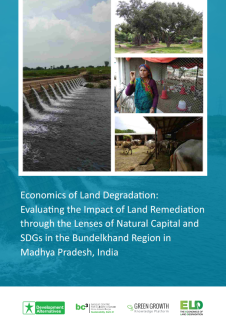
Land degradation causes loss of biodiversity and productivity of a particular land. It affects the entire natural environment through disruption in the ecological processes and has far reaching effects on human welfare and the economy of a country through decline in supply of vital ecosystem services. Several land and water based interventions have been made by the Development Alternatives Group through different programmes for land remediation in the semiarid, erratic rainfall prone and economically backward Bundelkhand region of Madhya Pradesh, India.
This study examined the costs and benefits of the implemented programmes by applying ELD methodology in three districts of Bundelkhand viz Datia, Shivpuri and Niwari by considering both intervention and control villages. The assessments looked into natural, social and human capital based on multiple indicators. The outcomes were obtained through quantitative and qualitative analysis of primary survey data and applications of GIS tools and models using satellite data. The findings of the study highlighted the differences in performances of different forms of capitals across intervention and control villages for the selected time period (2013- 2018). The findings reflected that land use changes have taken place in the study area during this period. Major improvements in agriculture were reported.
